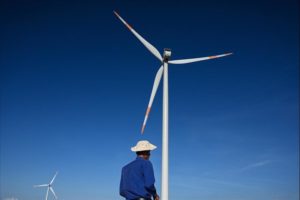 Thailand behind Vietnam in transition from fossil fuels to clean energy
Thailand behind Vietnam in transition from fossil fuels to clean energy
Thailand is lagging Vietnam in the race to transition from fossil fuels to clean energy in the post-Covid-19 world, where climate change is taking center stage as the next looming global crisis, and countries and companies race to become carbon-neutral.
And Thailand’s highly profitable energy companies, many of them nurtured to success via government-granted concessions and generous power purchase agreements, are at the forefront of the renewable energy (RE) blast off in neighboring Vietnam, potentially to Thailand’s long-term detriment if authorities don’t act fast.
Thailand has been promoting RE as an alternative source for electricity production for more than a decade, with moderate success. RE as a percentage of the energy mix rose from 2.1% in 2010 to 10.1% in 2019, and is expected to reach at least 20% by 2028, under the current Power Development Plan (PDP), published in 2019.
Thailand’s Energy Ministry is in the process of revising the PDP and is likely to announce more ambitious targets this November at the United Nations Climate Conference to be held in Stockholm, Sweden.
Thailand’s main RE sources are solar, hydro, biomass and, to a lesser degree, wind.
Under the 2019 PDP, Thailand’s solar capacity should double from 3,000 megawatts at year-end 2018 to 6,700 MW by 2028, while the biomass capacity will expand from 4,000 MW to 5,800 MW over the same time frame, according to a report by Fitch Solutions, the market research arm of Fitch Ratings.
Last year Vietnam’s solar production had already generated 16,640 MW, representing 24% of the energy mix, or nearly three times more than Thailand even hopes to attain over the next seven years.
The RE take off has been fueled by Vietnam’s rapid economic growth over the past five years, led by massive inflows of foreign direct investment (FDI) as multinational companies set up factories there to diversify their supply chains out of neighboring China – thanks to the US-China trade war – and to benefit from Vietnam’s still relatively cheap, abundant and well-educated labor force.
Vietnam on course
Economic growth and inflows of FDI have led to a huge surge in demand for energy/electricity, and with limited domestic power sources – local coal accounts for 29% of the energy mix, hydropower 30%, gas and diesel 13%, biomass 1.0%, wind 1.0% and imported power 2.0 %: Source: Vietnam PDP#7 – Vietnam has in recent years turned to promoting RE, chiefly solar and now wind.
“I think Vietnam has hit a home run in terms of solar,” said Frederick Burke, Managing Director of Baker McKenzie/Vietnam.“They are way above their original power development plan target at about double what they were targeting.”
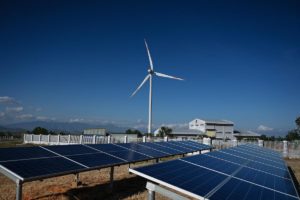
One reason for the clean energy boom is due to customer demand, specifically from brand-name consumer product conglomerates that are looking for a“Green supply chain” to satisfy their home market requirements for more climate-friendly goods.
“All the brand name shoes and electrical goods, all the consumer goods that come through here – they are looking for some sort of a green supply chain, so they are requiring their suppliers to do that,” said Burke.
Many new investments in Vietnam’s industrial estates have turned to rooftop solar as a quick, climatically correct fix for their own power needs and the green demands of their clients.“It is much easier if you can go to the Adidas or Nike factory and see the solar panels on the roof,” said Burke.
Thailand allows rooftop solar at its industrial estates too, with tax incentives from the Board of Investment (BOI), but most estates already have their own small power plants or can rely on the country’s well-established electricity grid.
The two countries are at very different stages of development. Thailand’s economy, which was one of the fastest-growing in the world between 1986 and 1996, has been slowing, labor costs rising, the population aging and private investment and FDI inflows have been tepid for the past seven-eight years.
And the country has a lot more electricity capacity than it needs. In 2020, when GDP contracted 6.1% during the Covid crisis and resulting lockdowns, Thailand’s power surplus amounted to 40% of installed capacity, whereas in normal years it stands at about 30%, industry sources say.
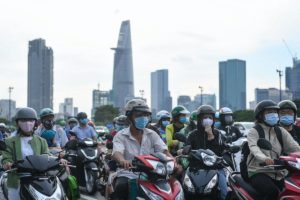
Meanwhile, Vietnam’s economy is surging – GDP was up 2.9% in 2020 despite the Covid crisis – exports are rising and FDI, although down 2% in 2020, is flowing in at about US$16 billion a year. Thailand’s FDI (inflow/outflow balance) dropped by $6 billion last year, partly because of the $10 billion divestment of Tesco (UK), which sold its local operations to Thailand’s giant Charoen Pokphand Group.
Vietnam needs all the new energy it can get to power its booming economy, and Thailand’s profitable energy giants are busy expanding abroad, with Vietnam a primary target. The sector has created a handful of new Thai billionaires in the past five years, including Sarath Ratanavadi, the CEO of Gulf Energy, and Somphote Ahunai, the CEO of Energy Absolute, ranked among the top 10 wealthiest Thai shareholders in 2020 by Money & Banking magazine.
Most of these energy companies are listed on the Stock Exchange of Thailand (SET), where listed companies reported a 137% jump in profits in the first quarter of 2021 year-on-year, driven in part by the energy sector, which accounts for 35-40% of the SET’s capitalization.
Energy companies have been at the vanguard of Thailand’s corporate outflows with FDI or mergers and acquisitions, primarily in the Southeast Asian region.
“I think most of the big energy companies have already gone to Vietnam, firstly, because it is a totally different story than Thailand,” said Obbon Thiracahi, senior analyst for corporates, at Fitch Ratings (Thailand).“Vietnam has the underdeveloped infrastructure, particularly power infrastructure, both in generation and transmission, so there are many opportunities for investment.”
Chaphamon Chantarapongphan, secretary-general of Thailand’s Renewable Energy Industry Club and senior executive vice-president at Super Energy Group, estimated:“For Thai investors in Vietnam we already have more than 5 gigawatts (5,000 MW) there.”
Super Energy Corp, for example, has already invested more than 20 billion baht ($628 million) in Vietnam, with nine solar projects with a total capacity of 837 MW, with six wind power plants underway which upon completion this year will generate another 550 MW.
“If we can make money there, we have to go,” said Chaphamon.“As an energy company, if I don’t grow in terms of megawatts I cannot grow my revenue, so I have to grow my MW, anywhere. Now we are looking at the Philippines, Indonesia and many places because Thailand does not have a clear policy (on RE),” he said.
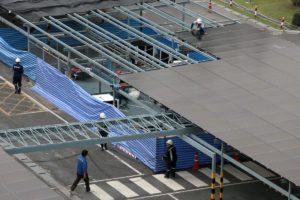
Thailand’s Renewable Energy Industry Club has been at the forefront of efforts to persuade the Thai government to speed up the country’s RE agenda.
There are signs that the Energy Ministry, responsible for setting energy policy, is listening.
“We have to change our long-term plan to adapt to the new landscape emerging in Thailand,” acknowledged Kawin Thangsupanich, Secretary to the Energy Minister, in an interview with Asia Times.“We are going to adopt a more competitive market. If we can create a more competitive market it gives us more flexibility to adjust ourselves to world trends.”
Thailand has not yet announced a deadline for achieving carbon neutrality, with 50% of the energy mix coming from RE. It is expected to do so at the upcoming UNCCC in Stockholm on November 12, along with providing a clearer picture on its other RE targets.
The Energy Ministry has its work cut out for it. Unlike Vietnam, Thailand has a very well-established energy infrastructure, and an entrenched power supply base sourced by a mix of powerful public and private players.
The state-owned Electricity Generating Authority of Thailand (EGAT), which generates 30-40% of Thailand’s electricity from its own power plants, has a near-monopoly over all electricity sales in the country along with its affiliates the Provincial Electricity Authority (PEA) and Metropolitan Electricity Authority (MEA).
PTT, the SET-listed semi-privatized national petroleum company, has a near monopoly over domestic sales and distribution of liquified natural gas (LNG), which in 2019 accounted for 57% of the national energy mix.
These powerful state-run entities pose the biggest obstacle to Thailand’s energy liberalization plans, observers say.

“We are trying to send the message to the government that if you have no clear policy on RE development for Thailand and you continue trying to facilitate big players like PTT or EGAT, PEA and MEA and try to protect them, then the flow of the investment, not just of FDI but our investment also, will flow to other countries,” said Chaphamon.
Thailand faces a tough challenge weaning itself off LNG, which was initially sourced from huge natural gas reserves found in the Gulf of Thailand in the late 1970s, but are now greatly depleted. Besides the offshore and onshore pipeline infrastructure, owned by PTT, Thailand has over the decades built up a massive petrochemical and plastics industry based on natural gas, which in the future will need to rely more on imports.
While LNG is deemed a cleaner fossil fuel than oil or coal, it is still carbon-based, so Thailand will need to cut its dependence on LNG dramatically over the coming decades if it wants to achieve carbon neutrality soon.
“I think for the natural gas sector, it is much more influential even than coal,” said Tara Buakamsri, Thailand Country Director for Greenpeace.“The coal industry in Thailand is shrinking, but natural gas and LNG is booming and it’s related to political connections. A few of the private companies [ LNG power plants operators] are very well connected to politicians, so LNG is king,” he said.
Many of the largest LNG-powered plants are owned by independent power producers (IPPs), which enjoy lucrative and long-term sales agreements with EGAT.
“For Thailand, I believe that we can do better than Vietnam if these three authorities – EGAT, PEA and MEA – start to invest or open up for the private sector to invest and create more buffer,” said Chaphamon.“Buffer means more energy storage at their substations, or at the power plants themselves. I think we can have a more reliable stable energy system than Vietnam on the national grid.”
Creating a smarter grid, to make it more flexible, will be a government priority for next year, promised Kawin, claiming it would create many private sector investment opportunities.
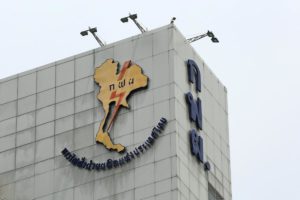
EGAT has long maintained that it needs to have a controlling stake in power production, managing the grid and electricity sales to secure the market and prevent dramatic price hikes for consumers.
“I think that in the past EGAT did quite well under the old structure, but now a new structure is coming in so we need a more flexible market in order to cope with the new environment,” Kawin said.
One area that has been stymied by EGAT has been solar rooftops for households. Although supported in theory by the government, the solar rooftop scheme has been a disappointment, primarily because Thailand has no net-metering scheme, allowing households to sell excess electricity back to the grid, and the red tape involved in putting up a few PV panels on your roof – permission is needed from the local district office and the city planning office, among others.
EGAT is seen as the main obstacle.
“They (EGAT) say that if the government opens up on solar rooftops there will be a disruption on the national grid because solar is not a baseload,” Greenpeace’s Tara said.“It is intermittent, so that means the stability of the grid would be disrupted by a decentralized energy system from solar rooftops.
“I think it is an excuse. They don’t want to allow the general public to be a producer and get money back for selling to the grid.”
With a capacity excess of 30-40%, surely EGAT can devise a smarter grid to assure an even electricity flow day and night, he noted.
Greenpeace estimates that if one million households in Thailand were allowed to generate rooftop solar energy, they could generate 2,000 MW of electricity while providing a new source of income for Thailand’s Covid-battered public, or at least reduce home electricity bills during the work-from-home period.
But Tara noted that past RE schemes have generally been set up to benefit the big energy players, not the little guys.
Legal Disclaimer:
MENAFN provides the information “as is” without warranty of any kind. We do not accept any responsibility or liability for the accuracy, content, images, videos, licenses, completeness, legality, or reliability of the information contained in this article. If you have any complaints or copyright issues related to this article, kindly contact the provider above.
Source: https://menafn.com/1102361613/Vietnam-blows-by-Thailand-in-clean-energy-race
